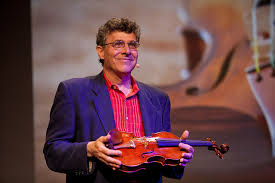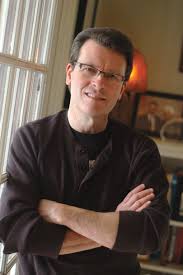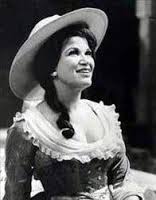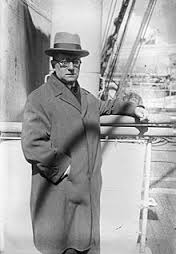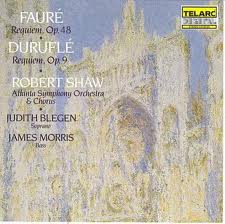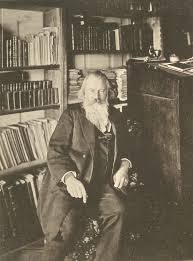
Take a moment and consider the vast number of nineteenth century symphonies which, in one way or another, take an unequivocal journey from darkness to light. The long arc of Beethoven’s Fifth Symphony, with its transcendent final movement, is a perfect example. In the opening of the last movement of Beethoven’s Fifth, C minor turns into C major, and the trombones (who wait through the first three movements without playing a note) suddenly add a new, heroically transformative voice to the mix.
By contrast, Johannes Brahms’ final symphonic statement, the Fourth Symphony, takes a starkly different road. Its opening sighs (later echoed in the third of Brahms’ Four Serious Songs, Op. 121) suggest melancholy lament. The ferocious concluding bars of the fourth movement tumble towards a resolution punctuated by a stern E minor chord (listen to the way the music loses its balance at 39:22 in the recording below). The dark finality of that last chord rings in our ears after the music is over. “Is that it?” we ask, feeling almost cheated out of the transfiguration we expected.
But the thorny realism of Brahms’ Fourth leaves us with a strangely powerful feeling of catharsis. The music evokes a complex, indescribable range of emotions. For example, in the opening of the first movement, consider the emotional ambiguity of the chord at 0:10. We might expect a simple, straightforward E minor chord at this moment, but listen to the way one added pitch in the woodwinds creates something infinitely more complex, mysterious and ambiguous.
Like Beethoven’s compositional style, Brahms’ music develops through short motivic cells, evolving, sometimes struggling, and working out a way forward. This sense of constant development led composer and Wagner enthusiast Hugo Wolf to accuse Brahms of “composing without ideas.” But in his 1933 essay, Brahms the Progressive, twelve-tone innovator Arnold Schoenberg suggested that Brahms’ compositional style (regarded as “conservative” during his lifetime) anticipated the breakdown of tonality in the twentieth century. Regardless, even some of Brahms’ friends were befuddled by the symphony when it was first performed, encouraging him to discard whole movements and allow others to remain as stand-alone pieces. On October 25, 1885, when Brahms performed a two piano version of the Fourth Symphony for friends (prior to its first official full orchestra premiere), the critic and Brahms champion Eduard Hanslick, who turned pages for the performance, said,
For this whole movement I had the feeling that I was being given a beating by two incredibly intelligent people.
Listening to the first movement, you may sense mystery and danger lurking somewhere beneath the surface. The sudden, ominous moment at 3:05 ushers in quiet, spirited fanfares which grow into emphatic statements. Notice the way this music returns throughout the movement. In the development section it plunges deeper into mysterious territory (5:19).
You’ll hear moments of incredible contrapuntal complexity. In his book, The Compleat Conductor, Gunther Schuller describes the music which follows 3:05 as,
a multi-layered structure of such complexity that I dare say there is nothing like it even in the Rite of Spring; one has to turn to Ives’s Fourth Symphony to find a parallel.
Instead of triumphantly returning to the recapitulation, we tiptoe, holding our breath (7:18). The first movement, which began with a restless sense of melancholy, ends in stern, resolute E minor.
The opening of the second movement is built on the ancient Phrygian mode and also hints at C major, but listen to the way we’re quickly pulled from this “wrong” key back into E minor. As the movement progresses, the theme we heard first in the solitary horn solo grows in intensity and scale. At 20:13 listen to the standoff between the winds and the strings. One of the aspects which makes this moment so amazing (and typical of Brahms) is the way the strings overlap with the winds and respond in asymmetrical phrases.
Brahms’ third movement is not a scherzo, as we would expect, but is instead built on Sonata form. Listen to the conversations taking place between instruments (the inner voices and bass at 24:42). Also, notice the addition of the triangle. What personas are suggested by these sounds?
A marriage of Romanticism and classical form occurs throughout Brahms’ music. The fourth movement looks back to the Baroque era, employing a passacaglia. Thirty variations are built on this repeating bass line, adapted from J.S. Bach’s cantata, Nach dir, Herr, verlanget mich, BWV 150. As you listen, consider the atmosphere of each variation. Do you hear a sense of lament in the music, which was present from the beginning of the first movement?
Here is Carlos Kleiber and the Vienna Philharmonic’s legendary performance of Brahms’ Symphony No. 4 in E minor, Op. 98:
[ordered_list style=”decimal”]
- Allegro non troppo (0:00)
- Andante moderato (12:50)
- Allegro giocoso (24:14)
- Allegro energico e passionato (30:22)
[/ordered_list]
Notable Recordings and Links
[unordered_list style=”tick”]
- Carlos Kleiber and the Vienna Philharmonic -the performance above.
- Bernard Haitink and the London Symphony
- Herbert von Karajan and the Berlin Philharmonic
- Daniel Barenboim and the Chicago Symphony
- Leonard Bernstein’s 1957 analysis of Brahms Fourth Symphony
- A Furtwangler rehearsal of Brahms Symphony No.4 from 1948
[/unordered_list]
Share your thoughts on Brahms’ Fourth Symphony and your favorite recordings in the thread below.

